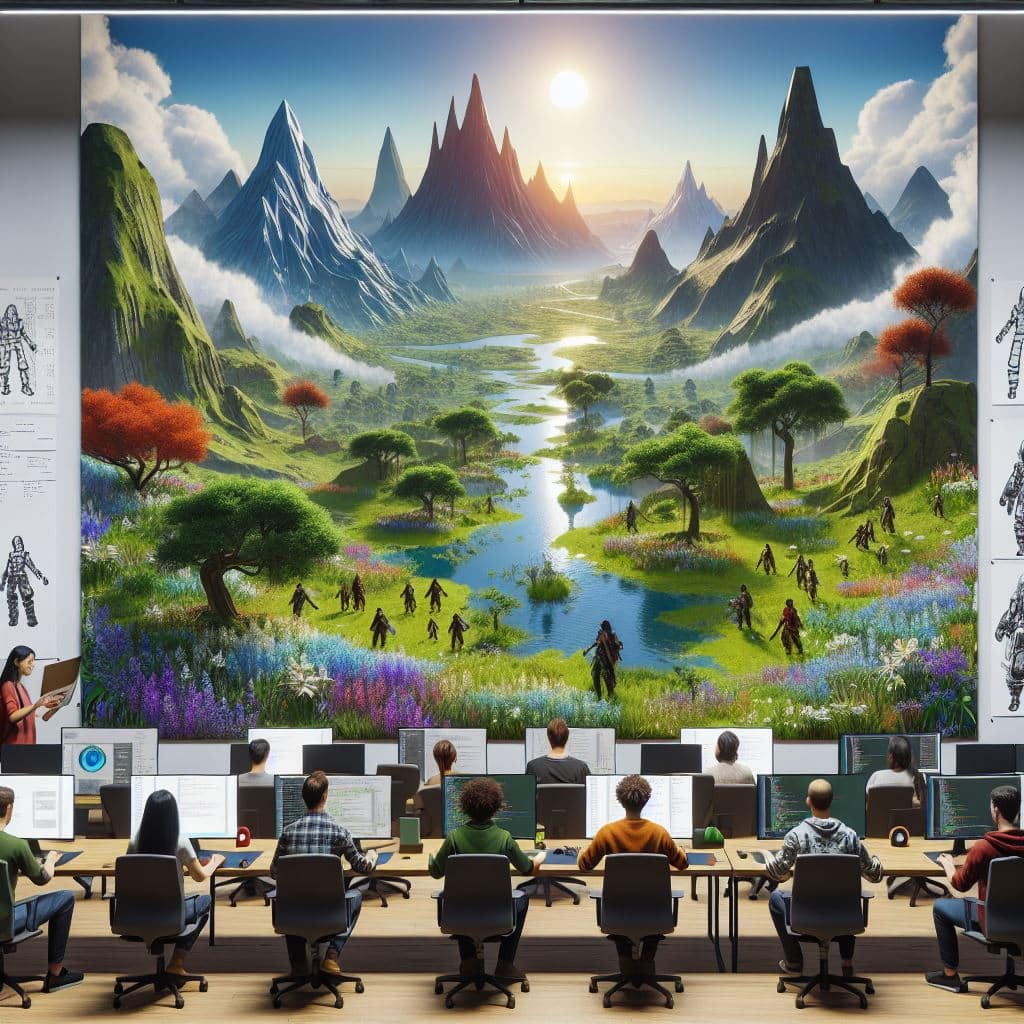Procedural generation has become a cornerstone of modern game development, empowering developers to create vast, dynamic, and varied game worlds. This technique enables games to deliver unique experiences every time a player dives into them, making it a key feature in many successful titles. In this post, we’ll dive into the ins and outs of procedural generation, explore its benefits, and provide a guide on how to implement it in your own projects.
What Is Procedural Generation?
At its core, procedural generation (PCG) refers to the use of algorithms and code to create game content dynamically, rather than having everything pre-built by hand. It can be used to generate various in-game elements such as levels, landscapes, dungeons, quests, and even characters.
Instead of designing every element manually, developers create rules and parameters that the algorithm follows. These rules dictate how the content is generated, leading to randomized yet consistent outputs.
For example, in a procedurally generated game, a dungeon will have a different layout every time the player enters it, but it will still follow predefined rules (e.g., always connected rooms, locked doors requiring keys, etc.).

Key Types of Procedural Content:
- Level Generation: Randomly generated dungeons, mazes, and landscapes (e.g., Rogue, Minecraft).
- Terrain Generation: Open-world games often use procedural generation for vast environments (e.g., No Man’s Sky).
- Character and Enemy Generation: Randomized stats, appearances, and abilities of NPCs.
- Quests and Stories: Dynamic, evolving storylines that change based on player actions or algorithms.
The Benefits of Procedural Generation
Procedural content generation offers several advantages for developers and players alike. Let’s explore these benefits:
1. Infinite Replayability
One of the most appealing aspects of procedural generation is the endless variety it can offer. In games like The Binding of Isaac or Spelunky, the unpredictability of level layouts ensures that no two playthroughs are ever the same. Players are always encountering new challenges, which adds a layer of excitement and surprise to the gameplay.
2. Smaller Team, Bigger Worlds
Instead of spending years manually creating levels, a small development team can rely on procedural algorithms to generate vast worlds. This is particularly useful for indie developers who may lack the resources to handcraft expansive environments. A well-designed procedural system can give the illusion of a large, rich world without the need for massive production teams.
3. Reduced Development Time
Since the content is algorithmically generated, developers can save significant time in designing every aspect of the game. This means fewer hours spent on level design, object placement, and enemy creation. In projects where development time is limited, procedural generation allows creators to focus on the core gameplay experience.
4. Engaging Emergent Gameplay
Procedural generation often leads to emergent gameplay—unexpected interactions and outcomes that arise naturally from the game’s systems. These can be thrilling for players as they encounter unique challenges or opportunities they hadn’t anticipated. For instance, in Dwarf Fortress, the complex interaction between its procedural systems creates stories and events that developers could never have imagined beforehand.
5. Cost-Efficient Content Expansion
As opposed to designing new levels or expansions, you can expand your game with additional procedural rules and elements, allowing the game to generate fresh content automatically. This makes procedural generation an attractive option for live-service or evolving games, as it provides new experiences without the need for extensive updates.
Challenges of Procedural Generation
While procedural generation is highly beneficial, it’s not without its challenges. Here are a few key issues developers may face:
- Balance and Quality Control
Because content is algorithmically created, it can be difficult to ensure that the results are balanced and enjoyable. A procedurally generated level may sometimes be too easy or too hard, or a terrain might not look as aesthetically pleasing as expected. Developers need to carefully fine-tune their algorithms to avoid such pitfalls. - Repetition and Predictability
Even though procedural generation aims to create variety, poorly implemented systems can lead to content that feels repetitive or predictable over time. Ensuring diversity and meaningful differences between generated elements is essential to keeping players engaged. - Testing Complexity
Since procedural generation can produce infinite possibilities, thoroughly testing every possible scenario can be a daunting task. While traditional games can test each level individually, procedurally generated games require more abstract testing methodologies.
Implementing Procedural Generation in Game Development
If you’re interested in implementing procedural generation in your own game, here are some practical steps to get started:
1. Define Your Parameters and Rules
The first step in procedural generation is determining the rules that govern how content will be created. For example, in level generation, you might decide:
- The player always spawns in a safe area.
- Levels should contain a certain number of enemies and loot.
- All areas must be accessible, with no dead-ends.
By setting these parameters, you ensure that your procedural content remains fun and consistent while retaining its variety.
2. Choose an Algorithm
Procedural generation relies heavily on algorithms to produce content. Here are some common techniques:
- Perlin Noise: Often used for terrain generation, Perlin noise creates smooth, organic-looking landscapes.
- Cellular Automata: Useful for dungeon and cave generation, this technique simulates the behavior of cells (such as walls and floors) to generate level layouts.
- Random Walks: A simple method for generating mazes or paths by moving randomly in different directions.
- Wave Function Collapse (WFC): A relatively new algorithm that generates content by assembling pre-designed tiles in a way that adheres to specific rules.
Each of these algorithms has its strengths, and the choice depends on the type of content you’re generating.
3. Modularity and Reusability
Procedural generation works best when the game is designed with modular components that can be combined in numerous ways. For example, in a dungeon crawler, you can create different room templates, enemy types, and traps that the algorithm can randomly piece together to form varied levels. The more modular and reusable your components are, the greater the potential for diversity.
4. Testing and Fine-Tuning
Because procedural content can produce unexpected results, testing is crucial. After implementing your algorithm, playtest it thoroughly to identify any recurring issues. Do certain levels become unfair? Are there areas where the generation feels too random or too predictable? Iteratively tweak your rules and parameters to balance fun, challenge, and variety.
5. Incorporate Procedural Elements Gradually
Instead of going full-procedural from the start, consider mixing handcrafted and procedural content. Some games, like Borderlands and Diablo, use handcrafted environments but procedurally generate loot, quests, or enemy encounters. This hybrid approach allows for a balance between creativity and replayability.

Use Case: Procedural Generation in Action
To see procedural generation in action, let’s explore Minecraft, one of the most iconic examples of this technique.
In Minecraft, terrain generation is driven by a combination of Perlin noise and custom rules. The game generates blocky landscapes of hills, forests, caves, and oceans as players explore. Each new world is unique, determined by a “seed” value that the procedural generation algorithm uses as a starting point.
Players can wander indefinitely, discovering new biomes, villages, and resources, all created on the fly. This approach not only gives Minecraft its endless replayability but also lets players feel like they’re exploring a genuinely living world.
Conclusion: Unlocking Creativity Through Procedural Generation
Procedural generation is a powerful tool for game developers looking to create engaging, dynamic, and varied experiences. Whether you’re generating entire worlds or just randomizing a few elements, this technique can enhance your game’s replayability, reduce development time, and introduce exciting emergent gameplay.
By carefully crafting your algorithms and rules, you can strike a balance between randomness and fun, ensuring that each playthrough feels fresh and unique. Whether you’re a seasoned developer or just starting, procedural generation opens the door to infinite creative possibilities in game development.



